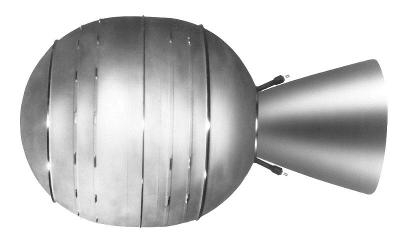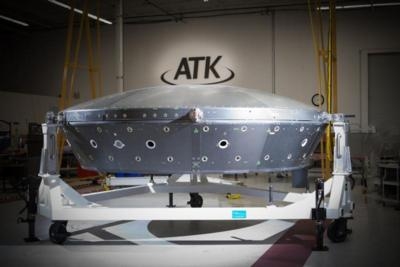Fri, Jul 04, 2014
STAR 48 Rocket Motor Carried LDSD Vehicle To Altitude Of Over 180,000 Feet
ATK supported NASA Saturday as it moved one step closer to landing advanced payloads on Mars following the successful test of a next generation braking system. ATK provided both the rocket motor and test vehicle backbone for the test of NASA's experimental Low-Density Supersonic Decelerator (LDSD). During the June 28 test at the Pacific Missile Range Facility at Barking Sands, Kauai, Hawaii, a balloon carried the test vehicle from the Navy test range to an altitude of about 120,000 feet. At 1105 local time, the LDSD test vehicle dropped away from the balloon and the ATK STAR 48B motor ignited to accelerate the vehicle to more than Mach 3.8 and an altitude of over 180,000 feet.

The flight test simulated the low pressure and punishing speeds experienced by payloads dropped into the Mars atmosphere. ATK's STAR 48B rocket motor provided the axial propulsion for the test, while the ATK-manufactured Core Structure Assembly (CSA) served as the platform for two breakthrough technologies from NASA's Jet Propulsion Laboratory (JPL): an inflatable Kevlar tube around the vehicle, called the Supersonic Inflatable Aerodynamic Decelerator, and a mammoth parachute called the Supersonic Disk Sail Parachute. These new drag devices will pave the way for delivery of increasingly larger payloads to the surface of Mars.
"ATK has long supported JPL and its missions to Mars," said Cary Ralston, vice president and general manager of ATK's Missile Products division. "ATK was an integral part of the team for Mars Pathfinder and Mars Exploration Rover, providing propulsion for the Delta II launch vehicle, and retro rockets and gas generators for the entry, descent and landing system used to safely deliver the rovers to the surface of Mars."

The STAR 48B propulsion system was produced at the ATK facility in Elkton, Maryland. The CSA for the LDSD test vehicle was developed and built at ATK's Space Components facility in San Diego, California. The CSA incorporates new design features required to handle the massive loads associated with deployment of the drag devices. Among other applications, this new drag technology will enable delivery of the supplies and materials needed for long-duration missions to the red planet.
While the LDSD team expects to learn a great deal from this test, NASA has two more saucer-shaped test vehicles forthcoming, with plans to test them in the summer of 2015.
(Images provided by ATK)
More News
NORDO (No Radio) Aircraft that cannot or do not communicate by radio when radio communication is required are referred to as “NORDO.”>[...]
Aero Linx: South Carolina Aviation Association (SCAA) Airports in South Carolina support the state’s economy and are themselves economic generators. Residents, businesses, an>[...]
Also: AV-8B Harrier For CAF Arizona, Boeing Gets ODA, Army NG Rescue, Longitude To C. America A California Superior Court judge recently ruled that GAMI’s unleaded avgas does>[...]
Also: Williams International Builds Up, Marines v Drones, NBAA v Tariffs, New GAMA Members Hermeus confirmed the flight of its Quarterhorse MK 1 aircraft at the Air Force Test Cent>[...]
A Few Questions AND Answers To Help You Get MORE Out of ANN! 1) I forgot my password. How do I find it? 1) Easy... click here and give us your e-mail address--we'll send it to you >[...]
 ANN's Daily Aero-Term (06.04.25): NORDO (No Radio)
ANN's Daily Aero-Term (06.04.25): NORDO (No Radio) ANN's Daily Aero-Linx (06.04.25)
ANN's Daily Aero-Linx (06.04.25) Airborne 06.04.25: G100UL Legal Decision, FAA v Starship, Laser Conviction
Airborne 06.04.25: G100UL Legal Decision, FAA v Starship, Laser Conviction Airborne-NextGen 06.03.25: Hermeus Quarterhorse, VFS Forum, VX4 eVTOL
Airborne-NextGen 06.03.25: Hermeus Quarterhorse, VFS Forum, VX4 eVTOL ANN FAQ: Q&A 101
ANN FAQ: Q&A 101




